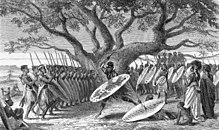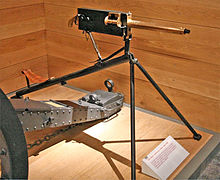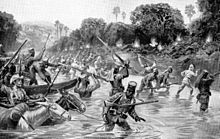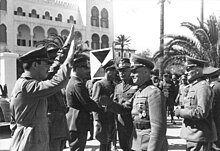Colonial Africa
The colonial history of Africa spans from colonial period until the postcolonial period in the history of Africa.
Southern Africa
By the 1850s, British and German missionaries and traders had penetrated present-day
The Herero entered into an alliance with the Germans, thinking they could get an upper hand on the Nama. The Germans set up a garrison at the Herero capital and started allocating Herero land for white settlements, including the best grazing land in the central plateau, and made tax and labor demands. The Herero and Ovambanderu rebelled, but the rebellion was crushed and leaders were executed. Between 1896 and 1897, rinderpest impaired the Herero and Nama economy and slowed white expansion. The Germans continued the policy of making Namibia a white settlement by seizing land and cattle, and even trying to export Herero labor to South Africa.[2]
In 1904, the Herero rebelled again. German General
Nguniland

A moment of great disorder in southern Africa was the
In 1828, Shaka was assassinated by his half brother
One of the major states to emerge from the Mfecane was the Sotho Kingdom founded at Thaba Bosiu by Moshoeshoe I around 1821 to 1822. It was a confederation of different polities that accepted the absolute authority of Moshoeshoe. During the 1830s, the kingdom invited missionaries as a strategic means of acquiring guns and horses from the Cape. The Orange Free State slowly diminished the kingdom but never completely defeated it. In 1868, Moshoeshoe asked that the Sotho Kingdom be annexed by Britain, to save the remnant. It became the British protectorate of Basutoland.[6]
Sotho-Tswana
The arrival of the ancestors of the Tswana-speakers who came to control the region (from the
At about the same time, the
At the time of these developments,
In 1822, Moshoeshoe established his capital at Butha-Buthe, an easily defensible mountain in the northern Drakensberg mountains, laying the foundations of the eventual Kingdom of Lesotho.[13] His capital was later moved to Thaba Bosiu.[13]
To deal with the encroaching
Aside from acting as state ministers, missionaries (primarily Casalis and Arbousset) played a vital role in delineating Sesotho orthography and printing Sesotho language materials between 1837 and 1855.[16] The first Sesotho translation of the Bible appeared in 1878.[17]
In 1868, after losing the western lowlands to the Boers during the Free State–Basotho Wars; Moshoeshoe successfully appealed to Queen Victoria to proclaim Lesotho (then known as Basutoland) a protectorate of Britain and the British administration was placed in Maseru, the site of Lesotho's current capital.[11] Local chieftains retained power over internal affairs while Britain was responsible for foreign affairs and the defence of the protectorate.[18] In 1869, the British sponsored a process by which the borders of Basutoland were finally demarcated.[11] While many clans had territory within Basutoland, large numbers of Sesotho speakers resided in areas allocated to the Orange Free State, the sovereign voortrekker republic that bordered the Basotho kingdom.
Voortrekkers
By the 19th century, most Khoikhoi territory was under
In the 1830s, Boers embarked on a journey of expansion, east of the
European trade, exploration and conquest

Between 1878 and 1898, European states partitioned and conquered most of Africa. For 400 years, European nations had mainly limited their involvement to trading stations on the African coast. Few dared venture inland from the coast; those that did, like the Portuguese, often met defeats and had to retreat to the coast. Several technological innovations helped to overcome this 400-year pattern. One was the development of
African germs took numerous European lives and deterred permanent settlements. Diseases such as
Strong motives for conquest of Africa were at play. Raw materials were needed for European factories. Europe in the early part of the 19th century was undergoing its Industrial Revolution. Nationalist rivalries and prestige were at play. Acquiring African colonies would show rivals that a nation was powerful and significant. These factors culminated in the Scramble for Africa.[23]


Knowledge of Africa increased. Numerous European explorers began to explore the continent.
Missionaries attempting to spread
The European powers set up a variety of different administrations in Africa, reflecting different ambitions and degrees of power. In some areas, such as parts of
In most areas colonial administrations did not have the manpower or resources to fully administer the territory and had to rely on local power structures to help them. Various factions and groups within the societies exploited this European requirement for their own purposes, attempting to gain positions of power within their own communities by cooperating with Europeans. One aspect of this struggle included what Terence Ranger has termed the "invention of tradition." In order to legitimize their own claims to power in the eyes of both the colonial administrators and their own people, native elites would essentially manufacture "traditional" claims to power, or ceremonies. As a result, many societies were thrown into disarray by the new order.[citation needed]
Following the Scramble for Africa, an early but secondary focus for most colonial regimes was the suppression of slavery and the slave trade. By the end of the colonial period they were mostly successful in this aim, though slavery is still very active in Africa.[27]
France versus Britain: the Fashoda crisis of 1898

As a part of the
European colonial territories

Belgium
- Congo Free State and Belgian Congo (today's Democratic Republic of the Congo)
- Ruanda-Urundi (comprising modern Rwanda and Burundi, between 1916 and 1960)
France
- French West Africa:
- Mauritania
- Senegal
- French Sudan (now Mali)
- French Guinea (now Guinea)
- Ivory Coast
- Niger
- French Upper Volta (now Burkina Faso)
- French Dahomey (now Benin)
- French Algeria (now Algeria)
- Tunisia
- French Morocco
- French Somaliland (now Djibouti)
- Madagascar
- Comoros
- French Equatorial Africa:
- Gabon
- Middle Congo (now the Republic of the Congo)
- Oubangi-Chari (now the Central African Republic)
- Chad
Germany
- )
- German East Africa (now Rwanda, Burundi and most of Tanzania)
- German South West Africa (now Namibia)
- )

Italy
- Italian North Africa (now Libya)
- Eritrea
- Italian Somaliland (now part of Somalia)
Portugal
- Portuguese West Africa (now Angola)
- Mainland Angola
- Portuguese Congo (now Cabinda Province of Angola)
- Portuguese East Africa (now Mozambique)
- Portuguese Guinea (now Guinea-Bissau)
- Cape Verde Islands
- São Tomé e Príncipe
- São Tomé Island
- Príncipe Island
- Fort of São João Baptista de Ajudá (now Ouidah, in Benin)
Spain
- Spanish Sahara (now Western Sahara)
- Spanish Morocco
- Tarfaya Strip
- Ifni
- Spanish Guinea (now Equatorial Guinea)
United Kingdom
- Egypt
- Anglo-Egyptian Sudan (now Sudan)
- British Somaliland (now part of Somalia)
- British East Africa:
- Kenya
- Uganda Protectorate (now Uganda)
- Tanganyika (1919–1961, now part of Tanzania)
- Zanzibar (now part of Tanzania)
- Bechuanaland (now Botswana)
- Southern Rhodesia (now Zimbabwe)
- Northern Rhodesia (now Zambia)
- British South Africa (now South Africa)
- Transvaal (now part of South Africa)
- Cape Colony(now part of South Africa)
- Colony of Natal (now part of South Africa)
- Orange Free State (now part of South Africa)
- The Gambia
- Sierra Leone
- Nigeria
- )
- British Gold Coast (now Ghana)
- Nyasaland (now Malawi)
- Basutoland (now Lesotho)
- Swaziland
Independent states
- Liberia, founded by the American Colonization Society of the United States in 1821; declared independence from the United States in 1847
- Ethiopian Empire (Abyssinia) had its borders re-drawn with Italian Eritrea and French Somaliland (modern Djibouti), briefly occupied by Italy from 1936 to 1941 during the Abyssinia Crisis;
- Sudan, independent under Mahdi rule between 1885 and 1899. It was then under British rule from 1899 to 1956.[31]
20th century
In the 1880s the European powers had divided up almost all of Africa (only Ethiopia and Liberia were independent). They ruled until after World War II when forces of nationalism grew much stronger. In the 1950s and 1960s the colonial holdings became independent states. The process was usually peaceful but there were several long bitter bloody civil wars, as in Algeria,[32] Kenya[33] and elsewhere. Across Africa the powerful new force of nationalism drew upon the organizational skills that natives learned in the British and French and other armies in the world wars. It led to organizations that were not controlled by or endorsed by either the colonial powers not the traditional local power structures that were collaborating with the colonial powers. Nationalistic organizations began to challenge both the traditional and the new colonial structures and finally displaced them. Leaders of nationalist movements took control when the European authorities exited; many ruled for decades or until they died off. These structures included political, educational, religious, and other social organizations. In recent decades, many African countries have undergone the triumph and defeat of nationalistic fervor, changing in the process the loci of the centralizing state power and patrimonial state.[34][35][36]

World War I

With the vast majority of the continent under the colonial control of European governments, the World Wars were significant events in the geopolitical history of Africa. Africa was a theater of war and saw fighting in both wars. More important in most regions, the

After World War I, colonial powers continued to consolidate their control over their African territories. In some areas, particularly in Southern and East Africa, large settler populations were successful in pressing for additional devolution of administration, so-called "home rule" by the white settlers. In many cases, settler regimes were harsher on African populations, tending to see them more as a threat to political power, as opposed to colonial regimes which had generally endeavored to co-opt local populations into economic production. The Great Depression strongly affected Africa's non-subsistence economy, much of which was based on commodity production for Western markets. As demand increased in the late 1930s, Africa's economy rebounded as well.
Africa was the site of one of the first instances of
World War II: Political

Africa was a large continent whose geography gave it strategic importance during the war. North Africa was the scene of major British and American campaigns against Italy and Germany; East Africa was the scene of a major British campaign against Italy. The vast geography provided major transportation routes linking the United States to the Middle East and Mediterranean regions. The sea route around South Africa was heavily used even though it added 40 days to voyages that had to avoid the dangerous Suez region. Lend Lease supplies to Russia often came this way. Internally, long-distance road and railroad connections facilitated the British war effort. The
Before the war, Britain had made few plans for the utilization of Africa, but it quickly set up command structures. The Army set up the West Africa Command, which recruited 200,000 soldiers. The East Africa Command was created in September 1941 to support the overstretched Middle East Command. It provided the largest number of men, over 320,000, chiefly from Kenya, Tanganyika, and Uganda. The Southern Command was the domain of South Africa. The Royal Navy set up the South Atlantic Command based in Sierra Leone, that became one of the main convoy assembly points. The RAF Coastal Command had major submarine-hunting operations based in West Africa, while a smaller RAF command dealt with submarines in the Indian Ocean. Ferrying aircraft from North America and Britain was the major mission of the Western Desert Air Force. In addition smaller more localized commands were set up throughout the war.[39]
Before 1939, the military establishments were very small throughout British Africa, and largely consisted of whites, who comprised under two percent of the population outside South Africa. As soon as the war began, newly created African units were set up, primarily by the Army. The new recruits were almost always volunteers, usually provided in close cooperation with local tribal leaders. During the war, military pay scales far exceeded what civilians natives could earn, especially when food, housing and clothing allowances are included. The largest numbers were in construction units, called Pioneer units, with over 82,000 soldiers. The RAF and Navy also did some recruiting. The volunteers did some fighting, a great deal of guard duty, and construction work. 80,000 served in the Middle East. A special effort was made not to challenge white supremacy, certainly before the war, and to a large extent during the war itself. Nevertheless, the soldiers were drilled and train to European standards, given strong doses of propaganda, and learn leadership and organizational skills that proved essential to the formation of nationalistic and independence movements after 1945. There were minor episodes of discontent, but nothing serious, among the natives.[40] Afrikaner nationalism was a factor in South Africa, But the pro-German Afrikaner prime minister was replaced in 1939 by Jan Smuts, an Afrikaner who was an enthusiastic supporter of the British Empire. His government closely cooperated with London and raised 340,000 volunteers (190,000 were white, or about one-third of the eligible white men).[41]
French Africa
As early as 1857, the French established volunteer units of black soldiers in sub-Sahara Africa, termed the Tirailleurs Sénégalais. They served in military operations throughout the Empire, including 171,000 soldiers in World War I and 160,000 in World War II.[42] About 90,000 became POWs in Germany. The veterans played a central role in the postwar independence movement in French Africa.[43][44]
World War II: Military

Since Germany had lost its African colonies following World War I, World War II did not reach Africa until
See also
References
- ^ Shillington (2005), pp. 218, 327–329, 340–342.
- ^ a b Shillington (2005), pp. 218, 327.
- ^ Shillington (2005), pp. 256–257, 270.
- ^ Shillington (2005), pp. 256–257.
- ^ a b Davidson (1991), pp. 274–275.
- ^ Shillington (2005), pp. 261–262, 271.
- ISSN 0525-5090.
- ^ Ross, R. (2009). A Concise History of South Africa. Cambridge: Cambridge University Press.
- ^ Muimui, Lubosi. "Political History of Barotseland". Archived from the original on 23 April 2014. Retrieved 9 January 2019.
- ISBN 978-1-57958-454-2.
- ^ a b c d Ross, R. (2009). A Concise History of South Africa. Cambridge: Cambridge University Press..
- ^ ISBN 9780300087765..
- ^ a b c Becker, P. (1969). Hill of destiny: the life and times of Moshesh, founder of the Basuto. London: Longman.
- ^ "Moshoeshoe". Encarta Encyclopedia. Redmond: Microsoft Corporation. 2003.
- ^ a b Sanders, P. (1975). Moshoeshoe, chief of the Basotho. London: Heinemann.
- ^ Casalis, E. (1992). The Basutos : or, twenty-three years in South Africa. Morija: Morija Museum & Archives.
- ^ Legassick, M. (1972). The Griqua, The Sotho–Tswana, and the Missionaries, 1780–1840. Ann Arbor: Univ. Microfilms International.
- ^ Grant, N. (1981). Moshoeshoe: Founder of a Nation. London: Longman..
- ^ Shillington (2005), pp. 215–216.
- ^ Shillington (2005), pp. 268–271.
- ^ Collins & Burns (2007), pp. 268–269.
- ^ Collins & Burns (2007), p. 269.
- ^ Collins & Burns (2007), p. 265.
- ^ Shillington (2005), p. 295.
- ^ a b Collins & Burns (2007), pp. 254–257.
- ^ "The Partition of Africa •". 2009-02-21. Retrieved 2022-05-24.
- ^ Lovejoy, Paul E. 2012
- S2CID 153431025.
- ^ D.W. Brogan, France under the Republic: The Development of Modern France (1870–1930) (1940) pp. 321–326
- ^ William L. Langer, The diplomacy of imperialism: 1890–1902 (1951) pp. 537–580
- ^ Martin & O'Meara (1995), pp. 135–138.
- ^ Alistair Horne, A savage war of peace: Algeria 1954–1962 (1977).
- ^ David Anderson, Histories of the hanged: The dirty war in Kenya and the end of empire (2005).
- ^ Gabriel Almond and James S. Coleman, The Politics of the Developing Areas (1971)
- ^ Festus Ugboaja Ohaegbulam, Nationalism in colonial and post-colonial Africa (University Press of America, 1977).
- ^ Thomas Hodgkin, Nationalism in Colonial Africa (1956)
- ^ Jackson (2006), pp. 171–239.
- ^ David Killingray and Richard Rathbone, edfs. Africa and the Second World War (1986).
- ^ Jackson (2006), pp. 175–177.
- ^ Jackson (2006), pp. 180–189.
- ^ Jackson (2006), pp. 240–245.
- ^ Robert Aldrich, Greater France: A History of French Overseas Expansion (1996) p. 223.
- ^ Raffael Scheck, "French African Soldiers in World War II." in Thomas W.Zeiler, ed., A Companion to World War II (2012): vol 1:501–515.
- ^ Ruth Ginio, The French Army and Its African Soldiers: The Years of Decolonization (U of Nebraska Press, 2017).
- S2CID 159589846.
- ^ Arthur Layton Funk, Charles de Gaulle: the crucial years, 1943–1944 (1959).
Bibliography
- Collins, Robert O.; Burns, James M. (2007). A History of Sub-Saharan Africa. NY: Cambridge University Press. ISBN 978-0-521-68708-9.
- ISBN 0-684-82667-4.
- Jackson, Ashley (9 March 2006). The British Empire and the Second World War. A&C Black. ISBN 978-0-8264-4049-5.
- Martin, Phyllis M.; O'Meara, Patrick (1995). Africa (3rd ed.). Bloomington: Indiana University Press. ISBN 0-253-20984-6.
- ISBN 0-333-59957-8.
